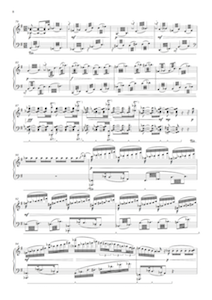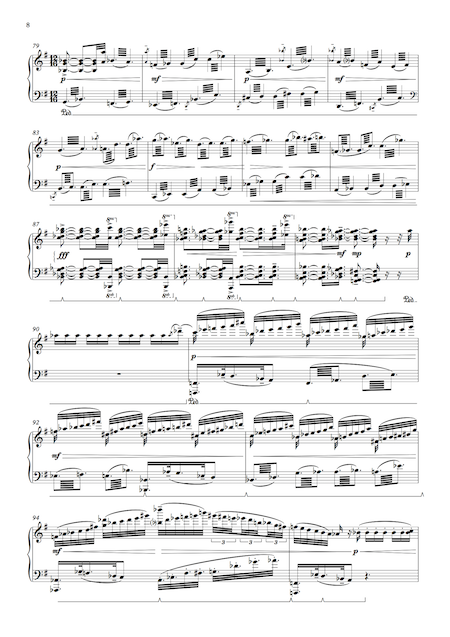Genieting VII
for piano (2015 | 17)
audio
00:00
/
00:00
Genieting VII - premiere by Bobby Mitchell
live recording by Bert van Dijk for the Concertzender | Composer Portrait: Willem Boogman, February 24, 2019
Orgelpark Amsterdam
live recording by Bert van Dijk for the Concertzender | Composer Portrait: Willem Boogman, February 24, 2019
Orgelpark Amsterdam
score sample


program notes
Genieting VII is based on the first movement of the piano sonata in G, D.V. 894 (1826) by Franz Schubert.
The performance of this sonata by Sviatoslav Richter made a deep impression on me. His extremely slow tempo gives each tone the space to sound, and due to his frequent use of the pedal a colorful nebula of sound is created above the music.
This listening experience reminded me of the wish to write a piano piece consisting of tremoli with depressed pedal. The use of these techniques evokes rich resonance via the soundboard from inside the piano. The ability to elicit this dim reverberation distinguishes the piano from other instruments.
So I came to compose Genieting VII, a piece for piano, which unfolds in the overtone regions of Schubert’s sonata through many tremoli with depressed pedal. Schubert's sonata is veiled, sometimes audible, often inaudible, but constantly present.
My music relates to that of Schubert as a ›self‹ that encloses the ›I‹. Or, as Giorgio Agamben quotes Giacomo da Lentini in ancient Italian: »no la persona, ma la sua figura« - the motto of the piece.
The working method I applied was roughly as follows: I made a selection of sixteen overtones based on the extent to which they deviate from the equal temperament, eight tones with a deviation more than fourteen cents and eight less than fourteen cents.
So I had eight four-part chords at my disposal: two for the right hand and two for the left, plus their four inversions. In general, these chords modulate along with the harmonic progress of Schubert’s sonata.
With this material I made my own composition, inspired per measure and per note by what I gradually came across in Schubert's music. Sometimes Schubert's melodic main points appear as signposts in my composition.
One of the elements that make up the cycle of solo pieces entitled Genieting is the discovery and utilization of the physical properties of the instruments. The soloist is challenged to controll these properties and apply them for a personal musical expression.
Genieting is the translation of the term ›jouissance‹ (enjoyment), as used by the French philosopher Emmanuel Levinas: »La jouissance est un retrait en soi, une involution. ... une exaltation vibrante où le soi se lève.« (Emmanuel Levinas, Totalité et Infini, La Haye, M. Nijhoff 1974, p. 91)
The Dutch title should be used at all times.
Willem Boogman, May 2017
(Translated by Sandra Macrander)
The performance of this sonata by Sviatoslav Richter made a deep impression on me. His extremely slow tempo gives each tone the space to sound, and due to his frequent use of the pedal a colorful nebula of sound is created above the music.
This listening experience reminded me of the wish to write a piano piece consisting of tremoli with depressed pedal. The use of these techniques evokes rich resonance via the soundboard from inside the piano. The ability to elicit this dim reverberation distinguishes the piano from other instruments.
So I came to compose Genieting VII, a piece for piano, which unfolds in the overtone regions of Schubert’s sonata through many tremoli with depressed pedal. Schubert's sonata is veiled, sometimes audible, often inaudible, but constantly present.
My music relates to that of Schubert as a ›self‹ that encloses the ›I‹. Or, as Giorgio Agamben quotes Giacomo da Lentini in ancient Italian: »no la persona, ma la sua figura« - the motto of the piece.
The working method I applied was roughly as follows: I made a selection of sixteen overtones based on the extent to which they deviate from the equal temperament, eight tones with a deviation more than fourteen cents and eight less than fourteen cents.
So I had eight four-part chords at my disposal: two for the right hand and two for the left, plus their four inversions. In general, these chords modulate along with the harmonic progress of Schubert’s sonata.
With this material I made my own composition, inspired per measure and per note by what I gradually came across in Schubert's music. Sometimes Schubert's melodic main points appear as signposts in my composition.
One of the elements that make up the cycle of solo pieces entitled Genieting is the discovery and utilization of the physical properties of the instruments. The soloist is challenged to controll these properties and apply them for a personal musical expression.
Genieting is the translation of the term ›jouissance‹ (enjoyment), as used by the French philosopher Emmanuel Levinas: »La jouissance est un retrait en soi, une involution. ... une exaltation vibrante où le soi se lève.« (Emmanuel Levinas, Totalité et Infini, La Haye, M. Nijhoff 1974, p. 91)
The Dutch title should be used at all times.
Willem Boogman, May 2017
(Translated by Sandra Macrander)
toelichting
Genieting VII is gebaseerd op het eerste deel van de pianosonate in G, D.V. 894 (1826) van Franz Schubert. De uitvoering van deze sonate door Sviatoslav Richter maakte diepe indruk op mij. Zijn extreem langzame tempo geeft elke toon ruimte om te klinken, en door zijn veelvuldig pedaalgebruik ontstaat boven de muziek uit een kleurrijke klanknevel.
Deze luisterervaring bracht mij de wens in herinnering een pianostuk te schrijven bestaande uit tremoli met het pedaal ingedrukt. Hierdoor wordt via de klankbodem vanuit het binnenste van de piano resonantie opgewekt. De mogelijkheid deze schemerige weerklank op te wekken onderscheidt de piano van andere instrumenten.
Zo kwam ik tot het componeren van Genieting VII, een stuk voor piano, dat zich door middel van veel tremoli met ingedrukt pedaal afspeelt in de boventoon-regionen van Schuberts sonate. Schuberts sonate is versluierd, soms hoorbaar, veelal onhoorbaar, maar voortdurend aanwezig.
Mijn muziek verhoudt zich tot die van Schubert als een ›zelf‹ die het ›ik‹ omhult. Of, zoals Giorgio Agamben Giacomo da Lentini citeert in het Oud-Italiaans: »no la persona, ma la sua figura« — het motto van het stuk.
De werkwijze die ik toepaste was globaal als volgt: ik maakte een selectie van zestien boventonen op grond van de mate waarin zij afwijken van de gelijkzwevende stemming, acht tonen met een afwijking groter dan veertien cents en acht kleiner dan veertien cents. Zo kon ik beschikken over acht vierstemmige akkoorden: twee voor de rechter- en twee voor de linkerhand plus hun vier omkeringen. Over het algemeen moduleren deze akkoorden mee met het harmonisch verloop van Schuberts sonate.
Met dit materiaal maakte ik een eigen compositie waarbij ik me per maat en per noot liet inspireren door wat ik gaandeweg tegenkwam in Schuberts muziek. Soms komen melodische hoofdpunten van Schubert te voorschijn als wegwijzers in mijn compositie.
In de cyclus van solostukken onder de titel Genieting gaat het er ondermeer om dat de fysieke eigenschappen van de instrumenten ontdekt en benut worden. Voor de solist gaat het er om die eigenschappen te beheersen en aan te wenden voor een persoonlijke muzikale expressie.
Genieting is de vertaling van de term ›jouissance‹, zoals gebruikt door de Franse filosoof Emmanuel Levinas: »La jouissance est un retrait en soi, une involution. ... une exaltation vibrante où le soi se lève.« (Emmanuel Levinas, Totalité et Infini, La Haye, M. Nijhoff 1974, p. 91)
Deze luisterervaring bracht mij de wens in herinnering een pianostuk te schrijven bestaande uit tremoli met het pedaal ingedrukt. Hierdoor wordt via de klankbodem vanuit het binnenste van de piano resonantie opgewekt. De mogelijkheid deze schemerige weerklank op te wekken onderscheidt de piano van andere instrumenten.
Zo kwam ik tot het componeren van Genieting VII, een stuk voor piano, dat zich door middel van veel tremoli met ingedrukt pedaal afspeelt in de boventoon-regionen van Schuberts sonate. Schuberts sonate is versluierd, soms hoorbaar, veelal onhoorbaar, maar voortdurend aanwezig.
Mijn muziek verhoudt zich tot die van Schubert als een ›zelf‹ die het ›ik‹ omhult. Of, zoals Giorgio Agamben Giacomo da Lentini citeert in het Oud-Italiaans: »no la persona, ma la sua figura« — het motto van het stuk.
De werkwijze die ik toepaste was globaal als volgt: ik maakte een selectie van zestien boventonen op grond van de mate waarin zij afwijken van de gelijkzwevende stemming, acht tonen met een afwijking groter dan veertien cents en acht kleiner dan veertien cents. Zo kon ik beschikken over acht vierstemmige akkoorden: twee voor de rechter- en twee voor de linkerhand plus hun vier omkeringen. Over het algemeen moduleren deze akkoorden mee met het harmonisch verloop van Schuberts sonate.
Met dit materiaal maakte ik een eigen compositie waarbij ik me per maat en per noot liet inspireren door wat ik gaandeweg tegenkwam in Schuberts muziek. Soms komen melodische hoofdpunten van Schubert te voorschijn als wegwijzers in mijn compositie.
In de cyclus van solostukken onder de titel Genieting gaat het er ondermeer om dat de fysieke eigenschappen van de instrumenten ontdekt en benut worden. Voor de solist gaat het er om die eigenschappen te beheersen en aan te wenden voor een persoonlijke muzikale expressie.
Genieting is de vertaling van de term ›jouissance‹, zoals gebruikt door de Franse filosoof Emmanuel Levinas: »La jouissance est un retrait en soi, une involution. ... une exaltation vibrante où le soi se lève.« (Emmanuel Levinas, Totalité et Infini, La Haye, M. Nijhoff 1974, p. 91)
